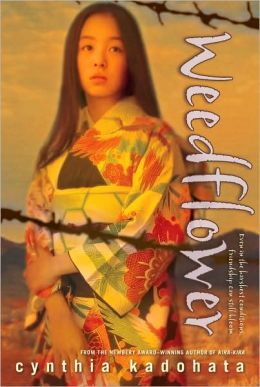Weedflower facts for kids
 |
|
| Author | Cynthia Kadohata |
|---|---|
| Cover artist | Lisa Vega |
| Country | United States |
| Language | English |
| Genre | Children's fiction |
| Set in | United States, 1941 |
| Published | 1 April 2006 |
| Publisher | Aladdin Paperbacks |
| Media type | |
| Pages | 260 |
| ISBN | 978-1-4169-7566-3 |
Weedflower is a historical novel for young readers. It was written by Cynthia Kadohata in 2006. She also wrote the famous book Kira-Kira. The story takes place in the United States during World War II. It is told through the eyes of Sumiko, a twelve-year-old Japanese-American girl. You can also listen to Weedflower as an audiobook. Kimberly Farr reads the story, which is about 6.5 hours long.
Contents
What the Story is About
The story begins in 1941. Sumiko, the main character, is invited to a birthday party. She brings a gift her uncle bought. But she is not allowed inside the house. This is because she is Japanese.
When Sumiko gets home, she tells a small lie. She does not want to upset her family. Later, she tells the truth to her cousin Bull and her little brother Tak-Tak.
Life Changes for Japanese-Americans
Soon after, something big happens. Japan bombs Pearl Harbor in Hawaii. The United States then declares war on Japan. Sumiko and her family must burn many things. They burn anything that might look "disloyal." This includes a photo of Sumiko's parents, who have passed away.
Sumiko is kept home from school. Her grandfather is arrested. He is a first-generation Japanese immigrant (called issei). He was also a principal at a Japanese school. Her uncle is arrested too. He used to lead a Japanese flower-growing group.
Moving to Camps
By the end of February, many Japanese people are arrested. More than 2,000 are wrongly taken to prison camps. Slowly, all Japanese people, including Sumiko's family, have to leave their homes. They must leave their belongings behind. They are forced to go to these camps.
Sumiko has to leave her family's flower farm. She moves twice. First, she goes to a camp at the San Carlos racetrack. Then, she moves to the Poston War Relocation Center. This camp is in Poston, Arizona.
Life in the Camp
When Sumiko arrives at the Poston camp, she meets new people. She meets Sachi and Mr. Moto. She also meets a Native American boy named Frank. Frank becomes her first true friend.
Sumiko starts a garden in the camp. This helps her remember her flower farm. It brings back good memories of her home in California.
A New Future
Several months later, the United States makes an announcement. Japanese people can leave the camps for jobs. At first, Sumiko does not want to go. But then, she leaves with her aunt. They go to work at a sewing factory in Illinois.
Her cousins, Bull and Ichiro, leave too. They go to fight in the army. Sumiko says a quick goodbye to Frank. She then leaves the camp. She hopes for a better future in Illinois.
Awards and Recognition
Weedflower has won many awards and been recognized by different groups:
- ALA Best Books for Young Adults Nominee
- ALA Notable Children's Book Nominee
- Agatha Award Finalist
- Booklist Editors' Choice
- CBC/NCSS Notable Social Studies Trade Book
- CCBC Choices (Cooperative Children's Book Council)
- Charlie May Simon Book Award ML (AR)
- Chicago Public Library's Best of the Best
- Dorothy Canfield Fisher Book Award Master List (VT)
- IRA/CBC Children's Choices
- Indian Paintbrush Book Award Master List (WY)
- Jane Addams Children's Book Award
- Kentucky Bluegrass Award Master List
- Keystone to Reading Book Award Master List (PA)
- Massachusetts Children's Book Award Master List
- Nene Award Master List (HI)
- Oppenheim Toy Portfolio Platinum Award
- PEN USA Literary Award for Children's Literature
- Texas Bluebonnet Master List
- Young Hoosier Book Award Master List (IN)

